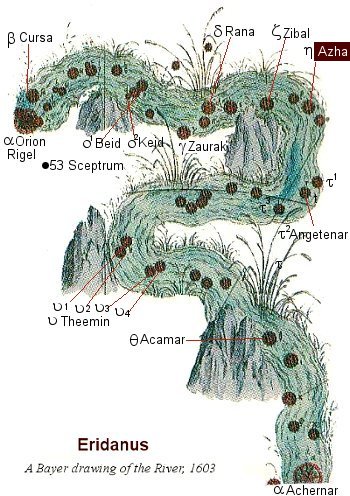| Fixed star: AZHA | |
| Constellation: Eta (η) Eridanus | |
| Longitude 1900: 07TAU21 | Longitude 2000: 08TAU45 |
| Declination 1900: -09.18′ | Declination 2000: -08.54′ |
| Right ascension: 02h 56m | Latitude: -24.32′ |
| Spectral class: K2 | Magnitude: 4.0 |
The history of the star: Azha
from p.218 of Star Names, Richard Hinckley Allen, 1889.
[A scanned copy can be viewed on this webpage

Azha is supposed to have been the Azha of the 10th century Persian astronomical writer Al Sufi, and the equivalent Ashiyane of the Persians, and was known by the 13th century Persian astronomical writer Al Kazwini as Al Udhiyy, being {p.219} chief among the stars of the Ostrich’s Nest, which the word signifies. The other components were zeta (ζ Zibal), rho (ρ), and sigma (σ); but this last, the 17th of the second-century Greek astronomer Ptolemy, is not now to be identified in the sky, although it may be one of the three stars rho (ρ) displaced by proper motion since the second-century Greek astronomer Ptolemy’s time.
Near eta (η this star Azha), towards tau (τ Angetenar), are some other stars — epsilon (ε) and pi (π) Cetus among them — which in early days were included in the Nest, but later were set apart by the 10th century Persian astronomical writer Al Sufi as Al Sadr al Ketus, the Breast of the Whale (Cetus).
Star Names, Their Lore and Meaning, Richard Hinckley Allen, 1889].
The astrological influences of the constellation Eridanus
Legend: Eridanus represents the river Padus or Po into which Phaeton fell when slain by Jupiter for having set the world on fire by misguiding the chariot of his father Phoebus. [Robson, p.44.]
Influences: According to Ptolemy all the stars with the exception of Achernar are like Saturn. Eridanus gives a love of knowledge and science, much travel and many changes, a position of authority, but danger of accidents especially at sea and of drowning. [Robson, p.44.]
References:
Fixed Stars and Constellations in Astrology, Vivian E. Robson, 1923].